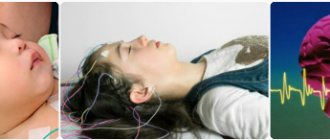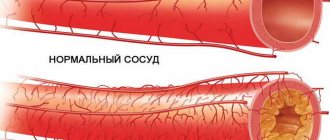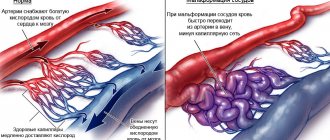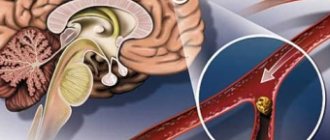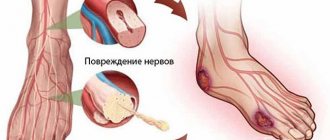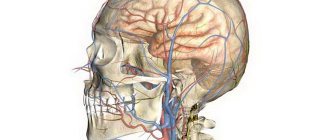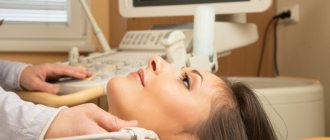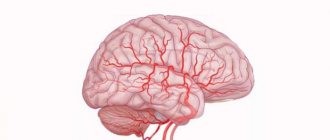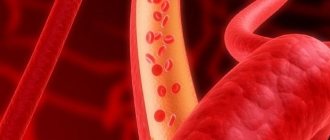Impaired blood supply to the brain with cervical osteochondrosis can have serious consequences. Compression of the blood collaterals of the cervical-collar zone leads to oxygen starvation of the most important parts of the brain and is the cause of arterial hypertension, deterioration of coordination and an increased risk of hemorrhage. Treatment of cerebral circulation in cervical osteochondrosis includes vascular drugs.
The essence and symptoms of circulatory disorders in osteochondrosis
The arteries of the spine pass through the transverse processes of the vertebrae of the neck, washing them with blood: the medulla oblongata, the brainstem, the cerebellum, the occipital lobes, and the inner ear. The medulla oblongata contains centers that coordinate vital functions: arterial tone, heart rate, breathing and swallowing. With cervical osteochondrosis, compression of the arteries occurs, as a result, insufficient blood flow to important areas. Blood circulation is limited and is a consequence of the occurrence of syndromes that determine the symptoms of insufficient blood flow:
- Spinal stenosis syndrome - compression of the blood vessels of the spinal cord disrupts blood circulation in the occipital area.
- Reflex-irritative syndrome – burning pain in the back of the head, worsening when inhaling/exhaling.
- Radicular syndrome (radiculopathy) - compression of nerve endings by the fibrous ring will manifest itself as headaches of varying localization and intensity. This syndrome is characterized by the following symptoms: Speech disorders.
- Deterioration of sense of smell.
- Decreased sensitivity of the tongue muscles.
- Feeling of a lump in the throat.
- Uneven breathing, snoring.
- Unreasonable nasal congestion.
- Vertebral artery syndrome is a throbbing pain indicating compression of a blood vessel. Pain in the superciliary region, temples, crown and back of the head. Symptoms: Dizziness.
- Noise or ringing in the ears.
- Mild nausea.
- Hypertension.
- Soreness in the eyes.
- Fainting state.
Since the spinal vessels provide nutrition to important areas of the central nervous system, impaired blood circulation in the brain with cervical osteochondrosis can provoke the occurrence of dangerous complications, in particular ischemic and hemorrhagic stroke.
What could be the consequences?
Impaired cerebral circulation in cervical osteochondrosis is often the cause of serious vascular and neurological problems. The medulla oblongata and brainstem contain vital coordinating centers:
- Vasomotor – regulates A/D.
- Regulation of heart rhythm - affects heart rate.
- Respiratory – controls the act of inhalation and exhalation.
- Swallowing – coordinates swallowing.
- The pituitary-hypothalamus system – hormonal balance.
Impaired blood supply to the brain with osteochondrosis can lead to serious complications, in particular stroke.
Impaired blood supply to the brain with osteochondrosis is a future vascular-neurological pathology, the treatment of which is delayed for months. Chronic circulatory failure is a common cause of dyscirculatory encephalopathy. A dangerous complication is a stroke, the consequences of which cannot be predicted. The appearance of the first signs of cerebral circulatory failure in osteochondrosis of the neck requires immediate medical attention.
Preventive measures
Prevention of cerebral circulation disorders in osteochondrosis will include treatment and improvement of the cervical spine. Compliance with a number of preventive requirements will reduce the risks of destructive changes and avoid compression of the neurovascular bundle. To do this you need:
Prevention of osteochondrosis for every person should be sleeping on the right mattress and pillow.
At the beginning of the disease, when the decrease in blood circulation is little noticeable, the symptoms are not regular and smoothed out and do not require treatment. Patients do not always associate the appearance of dizziness, headaches, deterioration in vision, memory and concentration with insufficient cerebral circulation due to osteochondrosis. Treatment of osteochondrosis often begins when blood circulation has deteriorated significantly. Therefore, prevention of circulatory failure will include timely treatment of cervical osteochondrosis, arterial hypertension and general improvement of the body.
Reasons for the development of pathology
In modern medical literature there is no detailed list of reasons that provoke the development of pathology. In each case, a complete analysis of the patient's health condition is required. The list opens with a spinal injury in the cervical region. Second place goes to excessive physical activity, such as lifting heavy objects. The more often a person tests his body for strength, the faster the cartilage tissue is destroyed.
In rare cases, the cause must be sought in hereditary pathologies. For example, a person may have a pathological change in the shape of one or more spinal discs. As a result, compression of the blood vessel develops. Weakening of the spinal column is often diagnosed in those who eat poorly, drink alcohol or smoke. The less nutrients the body receives, the weaker its bones.
Clinical manifestations of the disease
There are several symptoms, upon noticing which, the patient should immediately make an appointment with a doctor.
- frequent attacks of dizziness;
- migraine;
- the upper or lower limbs become numb for a short period of time;
- frequent fainting;
- sudden deterioration of vision;
- convulsions;
- Pain in the eyes;
- sudden attacks of nausea;
- feeling of fullness in the ears;
- increased fatigue;
- deterioration of mental activity;
- impaired coordination of movements.
The listed symptoms are characteristic of several diseases. The doctor will make an accurate diagnosis after an examination.
Effective treatments
Once the patient has been correctly diagnosed, the doctor prescribes a course of conservative therapy. It is aimed at eliminating symptoms and normalizing the blood circulation process.
The most common procedure is massage of the collar area. The procedure has proven to be effective in the short and long term. The course is selected by the doctor in such a way as to normalize the amount of oxygen entering the brain. The following procedures will help complement the massage:
- mud baths;
- UV radiation;
- electrophoresis;
- sound waves;
- laser treatment on the affected area.
The number of procedures and their duration are determined by the doctor.
The doctor will select the optimal course of exercises, taking into account the patient’s health condition. They are performed every day without fail.
The correct procedure is as follows. A 5-minute warm-up, including leisurely swings of your arms, rotation of your shoulders, or you can simply walk in place, will help prepare your body for the upcoming loads. Exercise I is used for a normalized load on the cervical spine - slowly tilting the head to the left and right. Within 10 seconds you need to smoothly lower your head to one side and then to the other.
Don't try too hard. During the exercise, a person will feel a slight muscle stretch.
As soon as the head has reached the end point, you need to stay there for 2-3 seconds, and after that, return the head to its original position. Every day, 5 sets of 2-3 repetitions are performed.
Another useful exercise is to smoothly raise and lower your shoulders. The recommended procedure is as follows:
- starting position: the person stands straight and his arms are along his body;
- smoothly raise your shoulders to the highest possible point;
- hold at the top point for 2-3 seconds;
- slowly lower your shoulders, moving them slightly back;
- Every day perform 1 set of 7 repetitions.
The third and final cycle of exercises is tilting the head forward. To perform the exercise, you must take into account the procedure described below:
- starting position: the person stands straight, with his arms along his body;
- gently lower your chin to the chest area;
- ensure that your shoulders remain as straight as possible;
- as soon as the chin touches the chest, you need to stay in this position for 3 seconds;
- smoothly return your head to its original position.
Every day perform 1 set of 8 repetitions.
The patient is prohibited from using medications independently. The final word always remains with the doctor. Only after a comprehensive study of the state of health will a person in a white coat select the right medicine and its optimal dosage. In medicine, there are several classes of drugs designed to improve blood circulation:
Effective only at the initial stage of the disease. Traditional medicine should not be used as an alternative to traditional medicine. It is recommended to use natural decoctions for internal and external use. A decoction based on parsley and dill has proven itself well. The recipe looks like this:
- 1 glass of boiling water;
- 150 g parsley;
- 150 g dill;
- put the herbs in a deep container and fill with water;
- put on low heat;
- Cook over low heat for 15-20 minutes;
- leave with the lid closed for 3 hours;
- take 2 times a day, morning and evening.
Every day a person prepares a fresh decoction. Using yesterday's preparation will not bring the desired result.
A similar requirement applies to tinctures based on lemon and garlic. It is prepared as follows:
- 2 ripe lemons;
- 3 heads of garlic;
- chop the garlic to a paste;
- squeeze juice from lemons;
- mix everything in a deep container;
- pour 1.5 cups of boiling water;
- cover the container with a lid;
- Leave for 2 hours.
The tincture should be taken 2 times a day, morning and evening. The recipes listed above are effective at the initial stage of the disease. If cervical osteochondrosis has become acute, then external agents will be needed to normalize the blood circulation process. With their help, the patient is given compresses and rubbing. The list of the most effective recipes is as follows.
A mixture of alcohol and iodine in a ratio of 30:1. The procedure is carried out once a day for 5 days. Positive changes are felt after 2-4 days. Another popular recipe is a compress based on honey and juice. It will help reduce the symptoms of osteochondrosis during exacerbation of the disease. It is prepared as follows:
- 3 tablespoons honey;
- 1 tablespoon fresh juice;
- mix everything in a bowl;
- I use the resulting mixture 2 times a day to apply compresses;
- duration of 1 procedure – 20 minutes;
- Course duration – 1 month.
Before using any folk remedy, you should talk to your doctor. Warming up the cervical spine does not always have a positive effect on your health.
It’s not just the diet that matters, but a balanced diet. The diet is selected by the doctor, based on the results of the examination. First of all, a person should give up salty foods. They contribute to the accumulation of salt in the body. The more it is, the worse the blood vessels work. Slow blood circulation is one of the main reasons for the development of degenerative changes in bone and muscle tissue. Food containing the following substances is prohibited:
Nishi Method
Nishi Katsudzo developed gymnastics aimed at improving oxygen supply to the brain and strengthening the body's defenses. To improve the functioning of the vegetative-vascular system and blood circulation, Nishi suggests the exercises presented below.
Position - lying on your back, hands under your neck. Bring your legs together, pull their toes towards you. Create vibration movements with your body, imitating the movements of a swimming fish. Movements should be directed to the right and left sides.
The duration of the exercise is at least two minutes.
While lying on your back, raise and fix your arms and legs in a vertical position. It is necessary to actively shake them for 2-3 minutes.
It is recommended to do Chinese gymnastics twice a day - morning and evening.
For the brain to work effectively, it needs oxygen. If blood circulation is impaired, the brain experiences oxygen starvation and, consequently, becomes unable to perform normal activities.
The Nishi technique will help strengthen blood vessels, improve blood circulation and provide oxygen to the brain.
The easiest and at the same time effective way is vibration exercise. They do it only after waking up, without getting out of bed. It is necessary to raise your arms and legs and shake them vigorously for several minutes. Warm-up will vibrate the capillaries and remove toxic substances and waste from the body, and also activate the nerves that stimulate the brain.
Nishi's technique also includes an exercise called the Goldfish. Do it while lying down, placing your hands behind your neck. Point your toes towards you and, tensed, produce vibrating movements of the entire body. Exercise activates blood movement and tones blood vessels.
For the brain to work effectively, it needs oxygen. If blood circulation is impaired, the brain experiences oxygen starvation and, consequently, becomes unable to perform normal activities.
The Nishi technique will help strengthen blood vessels, improve blood circulation and provide oxygen to the brain.
The easiest and at the same time effective way is vibration exercise. They do it only after waking up, without getting out of bed. It is necessary to raise your arms and legs and shake them vigorously for several minutes. Warm-up will vibrate the capillaries and remove toxic substances and waste from the body, and also activate the nerves that stimulate the brain.
Nishi's technique also includes an exercise called the Goldfish. Do it while lying down, placing your hands behind your neck. Point your toes towards you and, tensed, produce vibrating movements of the entire body. Exercise activates blood movement and tones blood vessels.
Possible complications
Lack of qualified medical care, incorrect or incomplete treatment lead to complications. We are talking about damage to blood vessels associated with certain parts of the brain. Doctors identify the following types of problems caused by cervical osteochondrosis:
- impaired coordination of movement - damage to the vessels supplying the cerebellum;
- malfunction of the vestibular apparatus is caused by pinching of the vessels leading to the inner ear;
- Damage to the vessels leading to the occipital region leads to weakened visual acuity.
Exercises for the blood vessels of the legs
Professor A. Sitel developed a method for restoring vascular functions. This technique involves muscle relaxation, to achieve which it is necessary to perform slow and rhythmic movements. The professor developed separate movements for each muscle group.
With the help of Sitela's exercises, you can achieve significant improvement in your condition without resorting to the use of pharmaceuticals. For example, headaches can be easily eliminated by restoring blood circulation.
The advantage of the Sitel method is that his exercises can be performed even by patients who have advanced spinal diseases.
- Stand against a wall, leaning your back and heels against it. Raise your arms above your head. You need to concentrate on your hands, and at the moment when they begin to spontaneously fall down, try to fix them, not allowing them to do this.
- To relax the muscles of the lumbar region, you need to stand with your back to the wall and raise your right leg up 90 degrees. Try to hold it in this position for at least 25 seconds. Repeat the exercise with your left leg. Perform alternate lifts with each leg 20 times.
- Stand up straight, place your fingers on the base of the sacrum. Inhale, counting to 10, while simultaneously pressing your fingers on the sacrum. In this case, you should push your fingers back with your back, creating resistance. Then you need to exhale deeply and repeat the exercise. Perform 5-6 times, gradually increasing the amplitude.
- For the vessels of the neck and head. Sit on a chair, tilting your head to the right and clasping it with your overstretched arm. The index finger of the left hand should hold the uppermost vertebra. Inhale, creating resistance with your right palm. As you exhale, relax the muscles and repeat the action with the other hand. Perform 10 approaches with each hand, gradually increasing the amplitude.
- To strengthen the blood vessels of the heart, while inhaling, it is necessary to raise the shoulder girdle as much as possible, fixing it in this position for 15 seconds. Then exhale and lower your shoulders down. Repeat at least 6 times.
It should be borne in mind that Sitela exercises have some contraindications. You cannot do gymnastics if:
- Presence of spinal injuries.
- Pregnancy.
- High blood pressure.
- The presence of acute chronic diseases.
- Serious neurological disorders.
- Disorder of the vestibular apparatus.
Diseases of the blood vessels of the legs are especially common, because they have to withstand heavy loads every day - prolonged standing, walking, lifting weights. For the vessels of the lower extremities it is recommended to do the following exercises:
- When standing, your feet are straight. You need to slowly rise on your toes and lower yourself. Perform 20-30 such lifts, and then spread your toes apart and repeat 20-30 raises on your toes again. Next, you need to bring your socks together and spread your heels and rise again on your toes 20-30 times.
- A good exercise for the blood vessels in the legs is walking on a flat surface. You need to walk in such a way that the soles of your feet do not leave the floor.
- Lying on your back, bend your knees and perform movements that imitate riding a bicycle. You need to pedal for 2-3 minutes, then take a short break and repeat the exercise again.
- In a lying position, you need to rotate your feet and legs to the right and left.
Prevention
Health problems are easier to prevent than to cure. Regular preventative visits to the doctor's office will help reduce the likelihood of developing cervical osteochondrosis. A person must undergo examination at least once a year. Prompt identification of postural abnormalities or spinal curvature will help the orthopedist quickly eliminate them. The second recommendation concerns regular, standardized physical activity. The doctor will give specific advice taking into account the person’s health status. Exercises are selected by a specialist in such a way as to strengthen the muscle corset.
In most cases, the orthopedist recommends that patients visit the pool for preventive purposes. It has been scientifically proven that water helps distribute the load evenly throughout the body. Reduces the likelihood of injury.
In addition to swimming, the man in the white coat will advise you to pay attention to water aerobics. In addition to the already listed practical tips aimed at preventing osteochondrosis of the cervical spine, there are a number of others in orthopedics:
- monitor your body weight - obesity is dangerous at any age;
- Do not expose the body to excessive physical stress;
- avoid sudden movements of the neck and arms;
- people who spend a lot of time sitting should take breaks and stretch from time to time;
- You should always ensure correct posture;
- Excessive long-term stress should not be a part of life;
- hypothermia several times increases the likelihood of developing osteochondrosis;
- if a person receives even a minor injury, you need to contact medical personnel - often osteochondrosis develops against the background of another injury, which at first glance seems insignificant;
- a person must give up tobacco and alcohol - substances contained in alcoholic drinks and cigarettes have a negative effect on blood vessels.
People who have a hereditary predisposition to cervical osteochondrosis should follow all doctor's recommendations.
Drinking regime plays an important role in the prevention of this disease. Every day an adult should drink at least 1.5-2 liters of clean drinking water. The longer the body experiences thirst, the faster tissues and joints lose life-giving moisture. The specific volume for each person will be determined by the doctor. He will take into account the patient's age, lifestyle, health status and season.
Breathing exercises
Breathing exercises will help expand and strengthen blood vessels, saturate the blood with oxygen, and lower blood pressure. The principle of breathing is similar for all such gymnastics: take a short deep breath through the nose, hold the breath, and then slowly exhale through the mouth.
Please note that to strengthen blood vessels, you should breathe through the right nostril. The fact is that breathing through the left nostril calms the body, helps get rid of migraines, high blood pressure, angina pectoris, and thyrotoxicosis. Breathing through the left nostril has a stimulating effect on the body, raises blood pressure, stimulates the thyroid gland, and increases vascular tone.
Breathing exercises will help enrich the blood with oxygen and strengthen blood vessels.
The following exercise will help increase the elasticity of blood vessels and raise vitality. You need to take a very deep breath through your nose and hold your breath for 3-5 seconds. Next, stretching your lips into a tube, blow out air, blowing away imaginary crumbs of bread from the table. Having exhaled some of the air, hold your breath again for 1-2 seconds. Then continue exhaling, pausing. There should be 10-15 exhalations per inhalation. Repeat 5-6 times.
The exercise will have an effect after the first time. In addition, it improves metabolism and has a beneficial effect on the thyroid gland.
Breathing exercises will help expand and strengthen blood vessels, saturate the blood with oxygen, and lower blood pressure. The principle of breathing is similar for all such gymnastics: take a short deep breath through the nose, hold the breath, and then slowly exhale through the mouth.
Please note that to strengthen blood vessels, you should breathe through the right nostril. The fact is that breathing through the left nostril calms the body, helps get rid of migraines, high blood pressure, angina pectoris, and thyrotoxicosis. Breathing through the left nostril has a stimulating effect on the body, raises blood pressure, stimulates the thyroid gland, and increases vascular tone.
Breathing exercises will help enrich the blood with oxygen and strengthen blood vessels.
The following exercise will help increase the elasticity of blood vessels and raise vitality. You need to take a very deep breath through your nose and hold your breath for 3-5 seconds. Next, stretching your lips into a tube, blow out air, blowing away imaginary crumbs of bread from the table. Having exhaled some of the air, hold your breath again for 1-2 seconds. Then continue exhaling, pausing. There should be 10-15 exhalations per inhalation. Repeat 5-6 times.
The exercise will have an effect after the first time. In addition, it improves metabolism and has a beneficial effect on the thyroid gland.
Regular breathing exercises will have a massaging, squeezing and stretching effect on the vessels, give the vessels elasticity and strength, prevent the formation of blood clots, improve performance, memory and attention, as well as calm the nerves and help avoid stress.
Almost all patients are recommended to do breathing exercises. It is contraindicated only in complex cardiovascular diseases and in the post-stroke state.
Breathing exercises help improve cerebral circulation and reduce vascular resistance. The main principle is to observe the breathing process. You need to inhale through your nose, then hold for a short time and exhale through your mouth.
In order to improve vascular blood flow and brain function, it is recommended to take a long breath and, after some delay, exhale briefly. A short inhalation with a long exhalation will help you calm down quickly.
You can breathe through one nostril, covering the other with your hand. When you close the left one, the pressure will decrease, heart function will normalize, and headaches will subside. Covering the right stimulates the functions of the endocrine glands and improves vascular tone.
It is recommended to do breathing exercises at least 2 times a day in a calm environment between meals.
Currently, several gymnastics complexes are known: qigong, according to the Buteyko, Strelnikova method, yoga.
Strelnikova method
A set of exercises developed by A. N. Strelnikova is aimed at normalizing blood circulation, improving heart function, and brain nutrition.
Gymnastics for cerebral vessels includes the following tasks:
- In a sitting position, rest your palms on your knees and lean forward a little. Breathe for 10-15 seconds, taking a series of 2-4 quick sharp breaths, between which take a ten-second break.
- Inhale quickly 8 times, simulating sniffing, wait 10 seconds and repeat 12 series.
- Place your fists at your waist. Inhale, lower your arms along your body, and as you exhale, return to the starting position.
Eastern gymnastics is based on calm and deep breathing.
Set of exercises:
- Sitting on a chair, put your legs to the sides, rest your hands on your knees, form your palms into a fist and place them on top of each other. Place your head on the top. Breathe deeply from your stomach, trying not to lift your chest.
- Stand up, place your hands on your stomach. Inhaling, stretch your stomach forward. Exhale through your lips, while pressing on your stomach.
- Stretch your arms up, taking a slow breath. Tilt to the left side, press on the body on the left side while exhaling. Repeat the task on the right side.
Yogic practices that improve blood circulation and stabilize blood pressure are an excellent way to normalize the activity of the cardiovascular and nervous system.
Yoga includes not only breathing techniques, but also static poses that involve alternating tension and relaxation of muscles. Meditation, which is an integral part of gymnastics, helps relieve mental stress:
- While standing, slowly inhale through your nose and at the same time rise onto your toes. After a delay, lower yourself onto your heels and exhale. Repeat 10 times.
- Exhale sharply, spread your arms to the sides, arch your back. Don't breathe for three seconds. As you exhale, return to the starting position.
- Take a slow and deep breath, hold your breath for up to 5 seconds, slowly exhale through pursed lips. Exhaling up to 15 times, hold your breath for 2 seconds and then continue. Repeat 5 series.
Breathing exercises help enrich the blood with oxygen, which acts as a natural vasodilator. There are several methods of breathing exercises - Strelnikova, Qigong, Yoga, deep breathing technique according to Buteyko.
Despite the fact that such techniques were developed by different specialists, all breathing exercises are built on similar principles and are performed by taking a deep breath through the nose, holding the breath and exhaling smoothly through the mouth.
For example, Sitel suggests lying with your back on a flat surface and exhaling as deeply as possible. Then you need to take a very slow breath through your nose, gradually drawing air back into your lungs. Inhalation must be done until the ribs straighten and acquire an arched position. If there is no dizziness or discomfort, perform 10 such inhalations and exhalations.
When performing yoga breathing exercises, inhalations and exhalations are accompanied by protrusion and retraction of the abdomen. Thanks to such techniques, it is possible to reduce blood pressure and normalize vascular function. With regular exercise, patients can get rid of hypertension forever.
Reviews
The doctor prescribed me a massage course. After several days the pain became less pronounced. I attended exercise therapy classes 2 times a week. The results of a repeated examination confirmed that the muscles had become stronger. If previously relapses occurred every year, now we are talking only about maintenance therapy.
Poor circulation as a result of osteochondrosis of the cervical spine is a serious pathology that requires medical intervention. At an early stage, the doctor will limit himself to conservative therapy. We are talking about a balanced diet, physiotherapy and exercise therapy. The patient’s task is to follow the doctor’s recommendations and give up bad habits. Choosing a healthy lifestyle will only speed up your recovery. In acute and chronic cases, the disease requires minimally invasive surgical intervention. The surgeon uses high-precision equipment to restore impaired blood flow.
In this article, will you learn about drugs that improve cerebral circulation in cervical osteochondrosis? Drugs used for vascular disorders. Other methods and methods for treating cerebrovascular disorders.
Author of the article: Victoria Stoyanova, doctor of the 2nd category, head of the laboratory at the diagnostic and treatment center (2015–2016).
Cervical osteochondrosis is a pathology with unpleasant symptoms (muscle spasms, pain) and even more unpleasant possible complications (brain circulatory disorders).
How do such complications arise? The vessels delivering blood to the brain tissues are compressed by a herniated intervertebral disc (one of the reasons). Their lumen narrows, the volume of blood and the amount of substances needed by the cells decrease.
As a result, in a patient with cervical osteochondrosis:
- I have regular headaches or dizziness;
- prolonged and noticeable noise or ringing in the ears;
- coordination of movements is impaired (a person is thrown from side to side, he staggers when walking);
- sleep disorders appear (insomnia, restless sleep).
If any of these symptoms appear, the doctor will prescribe treatment that can activate cerebral circulation.
In what ways and means is this achieved:
- Medicines (vasodilators, nootropics, venotonics, anticoagulants).
- Physiotherapeutic procedures (neck massage, manual treatment, therapeutic and preventive exercises).
- Orthopedic treatment (Schanz collar).
There are no special drugs to improve cerebral circulation in osteochondrosis.
Similar drugs are used to treat similar disorders in any disease that causes narrowing of blood vessels (hypertension or atherosclerosis).
For vascular complications of osteochondrosis, it is recommended to consult a neurologist (neurologist).
Strengthening blood vessels and heart
If a person has impaired blood circulation, he needs help. If this process is not stopped, pathological changes will begin, and this will complicate future life. This disease is usually treated with medications. Their action is aimed at:
- dilate blood vessels;
- make the blood more liquid.
Despite the presence of important positive effects, medications are not without side effects. They have contraindications. This means that some sick people will not be able to use the drugs, and the problem will not be solved.
There is a way out of this situation - physical exercise. At first glance, it is strange to play sports to improve problems with your head. But the fact remains: exercises have proven their effectiveness and safety, and they are successfully used not only as a therapeutic, but also as a preventive measure, because everyone wants such problems not to bother them at an older age.
What are their advantages? There are quite a lot of them. They contribute to:
- improving memory, attention, concentration and other cognitive functions of the brain;
- improved coordination of movements (which is common in older people);
- restoration of the function of the organs of vision;
- development of spinal mobility (this is the prevention and relief of pain due to osteochondrosis);
- reducing the risk of problems with blood vessels (prevention of thrombosis and strokes).
To reduce the risk of spasms, it is necessary to include exercises to strengthen blood vessels into the exercise routine. Moving the head in different directions, rotating the body, standing on the head, elbows and shoulder blades, lifting the legs in a lying position, as well as somersaults and circular rotations are effective.
Standing on one leg, as well as on two, will help activate cerebral circulation. Walking will improve blood circulation, increase vascular tone and provide the brain with oxygen. Exercise dilates arteries and increases blood flow to the brain.
The following exercises will help expand the arteries and improve blood flow in the brain:
- Rotate your head first clockwise and then in the opposite direction for 2-3 minutes.
- Raising your hands up, you need to make a “lock”. Bend forward, simulating chopping wood. Repeat 8 times.
- Take turns swinging your legs: the leg should move towards the opposite hand.
- Bend your knees slightly and spread your arms to the sides, make asynchronous movements: make rotational movements back with your right hand, and forward with your left and vice versa. Exercise will help improve memory, attention and concentration, as well as increase the speed of thinking.
- Perform straight leg raises, using your hands to support your lower back. At the end, stay in the “Berezki” stance for 5 minutes.
To perform the first 4 exercises, you need to stand with your feet shoulder-width apart. The fifth exercise is done lying on your back with your arms extended along your body.
Bends of the torso have an effective effect on the blood vessels of the brain.
To reduce the risk of spasms, it is necessary to include exercises to strengthen blood vessels into the exercise routine. Moving the head in different directions, rotating the body, standing on the head, elbows and shoulder blades, lifting the legs in a lying position, as well as somersaults and circular rotations are effective.
Standing on one leg, as well as on two, will help activate cerebral circulation. Walking will improve blood circulation, increase vascular tone and provide the brain with oxygen. Exercise dilates arteries and increases blood flow to the brain.
The following exercises will help expand the arteries and improve blood flow in the brain:
- Rotate your head first clockwise and then in the opposite direction for 2-3 minutes.
- Raising your hands up, you need to make a “lock”. Bend forward, simulating chopping wood. Repeat 8 times.
- Take turns swinging your legs: the leg should move towards the opposite hand.
- Bend your knees slightly and spread your arms to the sides, make asynchronous movements: make rotational movements back with your right hand, and forward with your left and vice versa. Exercise will help improve memory, attention and concentration, as well as increase the speed of thinking.
- Perform straight leg raises, using your hands to support your lower back. At the end, stay in the “Berezki” stance for 5 minutes.
To perform the first 4 exercises, you need to stand with your feet shoulder-width apart. The fifth exercise is done lying on your back with your arms extended along your body.
Bends of the torso have an effective effect on the blood vessels of the brain.
Even completely healthy people can suffer from impaired vascular tone. This condition is called vegetative-vascular dystonia. To normalize blood circulation, you need to perform the following exercises for the blood vessels of the brain:
- Stand against a wall, leaning your body tightly against it. Inhale so that your chest is pressed tightly against the wall and your neck muscles are tense as much as possible. Fix in this position for a few seconds, and then repeat the exercise.
- Squat down and place your palm on your forehead. Try to tilt your head forward, creating counteraction with your palm. The neck muscles should be tense. Remain in this position for at least 5 seconds.
- Next, you need to repeat the previous movements, tilting your head not forward, but to the sides.
- This exercise also gives a good effect: tilt your head to the side, and then carefully rotate it in a circle - first to the right and then to the left.
It is very beneficial for the heart and blood vessels to ride a bicycle, swim, walk up the stairs, and perform cardio exercises. The simplest and most effective among them are:
- Walking on your toes, raising your knees high.
- Simulation of cycling while lying on your back.
- Exercise “scissors” with legs, also lying on your back.
The main thing is to regularly perform exercises with strict cyclicity: the load should always be followed by relaxation. This helps to increase the muscle fibers of the heart and strengthen blood vessels.
Review of drugs for activating cerebral circulation in osteochondrosis
Drugs to improve cerebral circulation are prescribed to people who have shown signs of pathological changes (if the person is healthy, taking them is pointless and even dangerous).
Medicines help:
- completely relieve symptoms or reduce them;
- stop the development of pathology.
In the group of vasodilator drugs there are many drugs with different mechanisms of action.
Some - Vasobral, Pentoxifylline - improve cerebral circulation by blocking special receptors responsible for spasm and narrowing of vascular walls (including large arteries).
Others - Vinpocetine, Cavinton - simultaneously act on receptors that constrict small vessels, and also prevent the penetration of certain chemicals into cells and back (which affect the tone of the vascular walls of the brain).
Additional treatments
- physiotherapy (massage, manual therapy, exercise therapy);
- orthopedic means (Schanz collar, traction).
Neck traction
Massage of the collar area is an effective procedure, as a result of which:
- The removal of excess fluid from the affected area is enhanced.
- Spasmed muscles warm up and relax.
- Microcirculation in the right areas improves.
Allows you to get rid of some not very pronounced symptoms of problems with cerebral circulation (insomnia, headaches)
The effect of the massage does not last long (from 2 to 4 weeks)
Only a specialist can properly massage the collar area without harming the patient.
Maintains and enhances the effect of the use of vasodilators and other medications to improve cerebral circulation
Not prescribed for exacerbations of osteochondrosis and herniated intervertebral discs
Manual treatment of osteochondrosis is one of the most effective ways to restore the correct position of the vertebrae of the cervical spine using special movements (pressure, direction, stretching).
Manual therapy allows you to:
- remove all muscle tension and tension in the cervicothoracic region;
- restore the correct position of organs and tissues;
- improve their functions;
- relieve symptoms of osteochondrosis and its complications.
Prescribed in the late stages of osteochondrosis (even after the appearance of a hernia)
Manual treatment of cervical osteochondrosis can only be entrusted to a professional
The result lasts up to 6 months
Even a very good specialist can damage the cervical vertebrae or cause their displacement
| pros | Minuses |
| pros | Minuses |
| pros | Minuses |
| pros | Minuses |
| pros | Minuses |
| pros | Minuses |
Manual therapy of the cervical spine
Regularly performed exercises will help get rid of some symptoms of cerebral circulation disorders due to osteochondrosis of the cervical spine.
- stretch the neck muscles, relieving tension and relaxing them;
- strengthen muscles to maintain the spine in the correct physiological position;
- activate blood flow and blood supply to tissues and organs (among others, the brain).
To perform a set of exercises you do not need special physical training or a lot of time (it only takes 30 minutes a day)
Exercise therapy is most effective in combination with other means for the treatment of pathology
A noticeable improvement occurs by the end of 2–3 weeks of regular exercise.
| pros | Minuses |
Examples of physical therapy exercises for neck muscles.
Click on the photo to enlarge One of the orthopedic devices that help in the treatment of cerebrovascular accidents is the Shants collar (a support splint for the head).
Shants collar
Using an orthopedic collar:
- Restore the correct position of the cervical vertebrae.
- Increase the distance between them.
- Remove tension and pain.
- Improves blood circulation in the brain and cervical spine.
Orthopedic devices increase the effectiveness of medications used to improve cerebral circulation
You can wear the Shants collar no more than 3 hours a day (so that the neck muscles do not atrophy)
Surgical treatment is carried out:
- when restoring blood circulation to an organ is impossible using other methods;
- if the lumen of the blood vessels supplying the brain has been reduced by more than half.
Dancing and yoga are an ideal remedy for blood vessels
Dancing and yoga have an excellent effect on blood vessels, during which they train coordination of movements, enrich the blood with oxygen, improve blood circulation, increase the elasticity and tone of blood vessels. In addition, they help to get rid of psycho-emotional tension and stress, which is important for the health of blood vessels.
The following exercises will provide effective results in the treatment of vegetative-vascular dystonia:
- Taking a slow breath through your nose, you need to rise on your toes as much as possible and hold your breath. Returning to the starting position, you should relax and exhale slowly through your mouth. Do 10-15 repetitions.
- Taking a quick breath through your nose, throw your arms out to the sides, bending backwards. In this position, you need to hold your breath for 3 seconds. Then, after exhaling, lower your arms and relax your muscles. Repeat 7-10 times.
Dancing is an ideal way to strengthen blood vessels.
Dancing and yoga have an excellent effect on blood vessels, during which they train coordination of movements, enrich the blood with oxygen, improve blood circulation, increase the elasticity and tone of blood vessels. In addition, they help to get rid of psycho-emotional tension and stress, which is important for the health of blood vessels.
The following exercises will provide effective results in the treatment of vegetative-vascular dystonia:
- Taking a slow breath through your nose, you need to rise on your toes as much as possible and hold your breath. Returning to the starting position, you should relax and exhale slowly through your mouth. Do 10-15 repetitions.
- Taking a quick breath through your nose, throw your arms out to the sides, bending backwards. In this position, you need to hold your breath for 3 seconds. Then, after exhaling, lower your arms and relax your muscles. Repeat 7-10 times.
Dancing is an ideal way to strengthen blood vessels.
Prognosis for vascular disorders
The prognosis for circulatory disorders depends on how much the brain is damaged.
The appearance of mild symptoms (noise and ringing in the ears) indicates the onset of vascular changes. Such signs (even if they are temporary) are a reason to start treatment so as not to start the process. In 90% of cases, a course of therapy for 2–4 weeks is sufficient to relieve symptoms.
The next stage is the appearance of more serious symptoms (sudden fainting, problems with remembering and transmitting information). Due to a lack of oxygen, pockets of non-functioning cells appear in the brain, but even at this stage it is possible to stop the progress of the pathology.
Medicines will have to be taken for a long time (from 2 to 6 months), repeating courses of treatment 1-2 times a year (sustained improvement can be achieved in 60-80% of cases).
The last stage occurs when cerebral circulatory disorders become critical. They can cause:
- stroke (acute cerebral circulatory disorder);
- disability (according to some sources - from 1 to 4% of patients).
Such changes are difficult to correct with medication, and the patient’s treatment continues for the rest of his life.
How to exercise correctly
Breathing is the basis of life. But few people think about the fact that you need to breathe correctly. And many health problems are associated with this. Most people breathe shallowly. Therefore, the blood is poorly enriched with oxygen, carbon dioxide remains in the lungs. This leads to slower blood circulation.
Therefore, it is very important to use the entire volume of the lungs during breathing. This affects the functioning of the blood vessels in the brain. Correct inhalation begins from the stomach, then the chest rises, then the shoulders. As you exhale, you should try to release all the air from your lungs.
Breathing exercises can be performed several times a day. The only condition for classes is the opportunity to relax and get distracted. It is not advisable to exercise immediately after or before meals. If breathing exercises are performed when the blood vessels in the brain are narrowed, you should consult a doctor before doing so.

